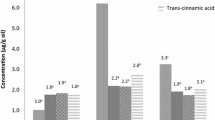Abstract
The physicochemical properties of oil from Rosa affinis rubiginosa seeds were analyzed after extraction by (i) organic solvent, (ii) cold pressing, and (iii) cold pressing assisted by enzymatic pretreatment using a mixture of the Novo-Nordisk A/S products Cellubrix (cellulase and hemicellulase activities) and Olivex (pectinase, cellulase, and hemicellulase activities). There were no significant differences in oil quality parameters, such as iodine value, refractive index, saponification value, unsaponifiable matter, and FA profile, when applying any of the three extraction processes. Although significant variations were observed in FFA content (acid value) and PV of the oil obtained by both of the cold-pressing oil extraction processes, these results were lower than the maximum value established from the Codex Alimentarius Commission. All-trans-retinoic acid content improved by 700% in rosehip oil obtained through cold pressing, with and without enzymatic pretreatment, in comparison with organic solvent extraction. This result is quite important for cosmetic oil because all-trans-retinoic acid is the main bioactive component responsible for the regenerative properties of this oil.
Similar content being viewed by others
References
Rosenthal, A., D.L. Pyle, and K. Niranjan, Aqueous and Enzymatic Processes for Edible Oil Extraction, Enzyme Microb. Technol. 19:402–420 (1996).
Moure, A., J. Sineiro, D. Franco, R.I. Santamaría, C. Soto, H. Domínguez, M.J. Núñez, M.E. Zúñiga, R. Chamy, J.M. Lema, and A. López-Munguía, Enzyme-Aided Alternative Processes for the Extraction of Oil from Rosa rubiginosa J. Am. Oil Chem. Soc. 78:437–439 (2001).
Concha, J., C. Soto, R. Chamy, and M.E. Zúñiga, Effect of Enzymatic Pretreatment on Rose Hip Oil Extraction: Hydrolysis and Pressing Conditions, —Ibid. 81:550–552 (2004).
Barros, S., X. Ling, M. Galea, F. Carvajal, and E. Fernández, Estudio Fotobiologico del Aceite de Rosa Mosqueta (Rosa aff. rubiginosa L.), Acta Farm. Bonaerense 7:3–8 (1988).
Pareja B., and H. Kehl, Contribution to the Identification of Rosa aff. rubiginosa L. Oil Rose Active Principles. An. Real Acad. Farm. 56:283–294 (1990).
Bocevska, M., D. Karlovic, J. Turkulov, and D. Pericin, Quality of Corn Germ Obtained by Aqueous Enzymatic Extraction, J. Am. Oil Chem. Soc. 70:1273–1277 (1993).
Domínguez, H., M.J. Núñez, and J.M. Lema, Aqueous Processing of Sunflower Kernels with Enzymatic Technology, Food Chem. 53:427–434 (1995).
Zúñiga, M.E., R. Chamy, and J.M. Lema, Canola and Chilean Hazelnut Products Obtained by Enzyme-Assisted Cold-Pressed Oil Extraction, in Proceedings of the World Conference and Exhibition on Oilseed Processing and Utilization, edited by R.F. Wilson, AOCS Press, Champaign, IL, 2001, pp. 203–209.
Domínguez, H., M.J. Núñez, and J.M. Lema, Enzyme-Assisted Hexane Extraction of Soya Bean Oil, Food Chem. 54:223–231 (1995).
Sosulski, K., and F.W. Sosulski, Enzyme-Aided vs. Two-Stage Processing of Canola: Technology, Product Quality and Cost Evaluation, J. Am. Oil Chem. Soc. 70:825–829 (1993).
Tano-Debrah, K., and Y. Ohta, Enzyme-Assisted Aqueous Extraction of Shea Fat: A Rural Approach, —Ibid. 72:251–256 (1995).
Sitohy, M.Z., F.H. Badr, M. Perifanova-Nemska, and T.S. Khadjiski, Characterization of Enzymatically Extracted Sunflower Seed Oil as Well as the Protein Residues, Grasas Aceites 44:345–347 (1993).
Instituto Nacional de Normalización, Nch 485. Granos o Semillas Oleaginosas. Determinación del Extracto al Éter de Petróleo Denominado Contenido de Aceite. Santiago de Chile, Chile, 1988, 5 pp.
Association of Official Analytical Chemists, Official Methods of Analysis of the Association of Official Analytical Chemists, 15th edn., edited by K. Helrich, AOAC, Arlington, VA, 1990, pp. 776–782.
Metcalfe, L.D., A.A. Schmitz, and J.R. Peika, Rapid Preparation of Fatty Acid Esters from Lipids for Gas Chromatographic Analysis, Anal. Chem. 38:514–515 (1966).
Guiso, G., A. Rambaldi, B. Dimitrova, A. Biondi, and S. Caccia, Determination of Orally Administered All-trans-retinoic Acid in Human Plasma by High-Performance Liquid Chromatography, J. Chromatogr. B. Biomed. Sci. Appl. 656:239–244 (1994).
Van Soest, P.J., and R.H. Wine, Determination of Lignin and Cellulose in Acid Detergent Fiber with Permanganate, J. Assoc. Off. Anal. Chem. 51:780–785 (1968).
Van Soest, P.J., J.B. Robertson, and B.A. Lewis, Methods for Dietary Fiber, Neutral Detergent Fiber, and Non Starch Polysaccharides in Relation to Animal Nutrition, J. Dairy Sci. 74:3583–3597 (1991).
Carbonell, E., E. Costell, and L. Durán, Determination of Pectin Content in Vegetable Products, Rev. Agroquim. Aliment. 30:1–9 (1990).
Miller, G.L., Use of DNS Reagent for Determination of Reducting Sugars, Anal. Chem. 31:426–428 (1959).
Hornero-Mendez, D., and M.L. Minguez-Mosquera, Carotenoid Pigments in Rosa Mosqueta Hips, an Alternative Carotenoid Source for Foods, J. Agric. Food Chem. 48:825–828 (2000).
Tano-Debrah, K., and Y. Ohta, Aqueous Extraction of Coconut Oil by an Enzyme-Assisted Process, J. Sci. Food Agric. 74:497–502 (1997).
Olsen, H.S., Aqueous Enzymatic Extraction of Oil from Seeds, in Asian Food Conference Proceedings, Bangkok, Thailand. Reprinted by Novo Industry A/S, A-06041a, 1988.
Szentmihályi, K., P. Vinkler, B. Lakatos, V. Illés, and M. Then, Rose Hip (Rosa canina L.) Oil Obtained from Waste Hip Seeds by Different Extraction Methods, Bioresour. Technol. 82:195–201 (2002).
Author information
Authors and Affiliations
Corresponding author
About this article
Cite this article
Concha, J., Soto, C., Chamy, R. et al. Effect of rosehip extraction process on oil and defatted meal physicochemical properties. J Amer Oil Chem Soc 83, 771–775 (2006). https://doi.org/10.1007/s11746-006-5013-2
Received:
Accepted:
Issue Date:
DOI: https://doi.org/10.1007/s11746-006-5013-2




